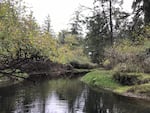The coastlines of Oregon and Washington take many different forms: sandy beaches, rocky headlands, marshy flats, and swampy tidal forests of salt-tolerant Sitka spruce. These tidal swamps were once the primary type of coastal wetland in Oregon, but development since European settlement has destroyed more than 90% of that original habitat.
The loss has been consequential ecologically (especially for coastal salmon habitat), but a hidden significance of these wetland losses is now coming into focus.
New research from the Pacific Northwest Blue Carbon Working Group shows that forested tidal swamps store more carbon than any other coastal ecosystem on the West Coast of the United States and Canada.
The researchers, from universities and nonprofits across the region, examined more than 1,000 core samples from different locations along the coast from Mexico to Alaska. They found that in the top meter of soil alone, coastal swamps store about 145 metric tons of organic carbon per acre — about the same as the annual CO2 emissions from 115 cars. This is up to 50% more than the carbon stored in salt marshes.

Forested tidal swamps, like this one on the coast of Oregon, feature some of the largest below-ground carbon stocks in the world.
courtesy of Chris Janousek
While the paper doesn’t gauge how quickly climate change-causing carbon dioxide can be removed from the air and stored in the sediment of these swamps, it does show that these coastal ecosystems have some of the largest carbon storage vaults available.
The research suggests that if you’re trying to maximize carbon sequestration — something that’s becoming increasingly important in light of human-caused climate change — restoring tidal swamps in the Pacific Northwest could be a very good place to start.
The research is published in the journal Global Biogeochemical Cycles.
In these All Science Snapshots, “All Science. No Fiction.” creator Jes Burns features the most interesting, wondrous and hopeful science coming out of the Pacific Northwest.
Find full episodes of “All Science. No Fiction.” here.
And remember: Science builds on the science that came before. No one study tells the whole story.
